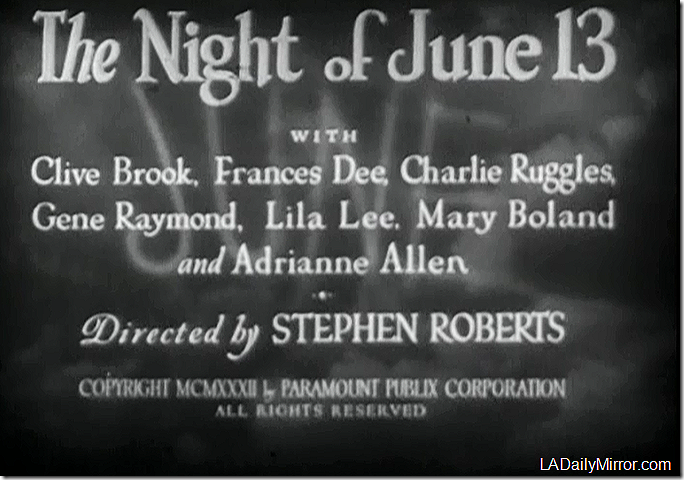
In case you just tuned in, I am using Louella Parson’s May 15, 1944, item on Rouben Mamoulian being replaced as the director of “Laura” to take a detour into the making of the film.
We have looked at the life and early career of author Vera Caspary, whose novel was the basis for the film, and I decided that before delving into “Laura” it might be useful to look at some earlier films based on Caspary’s stories.
In her autobiography, she bragged of writing eight different versions of the same story (“Suburb”) starting in 1932 and selling them to the studios before she was finally confronted by Paramount and told to stop or risk charges of plagiarism. Paramount’s position is understandable. In addition to the matter of paying for the same story again and again, at least one of the films was made by a rival studio — Fox. In this post, we’ll take a look at some of those films, because as unlikely as it seems, they provide some of the foundation for “Laura.”
The Making of “Laura” Part I | Part II | Part III | Part IV | Part V | Part VI
Warning: Spoilers ahead.

Elna Curry (Adrianne Allen) spies on her husband, whom she wrongly suspects of having an affair with neighbor Trudie Morrow (Lila Lee).
What’s important about “Suburb,” the root story of all the others, is that Caspary calls it “a murder story without a murder.” In each version, a suicide is misinterpreted as a murder until the truth is revealed at the last minute and the innocent person is cleared. Caspary rearranges her cast of characters somewhat in these later versions, but she leaves the plot’s underlying mechanism untouched.
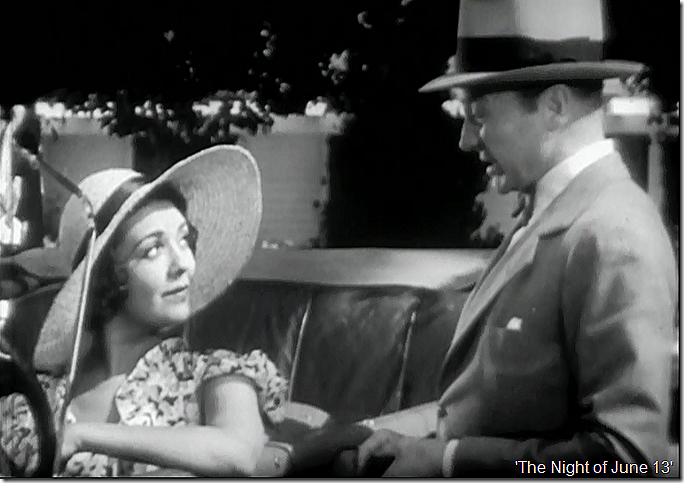
The relationship between Trudie Morrow (Lila Lee) and John Curry (Clive Brook) is entirely aboveboard, but provokes gossip among the neighbors and makes his wife insanely jealous.
Although it’s not entirely accurate to call “Laura” “a murder story without a murder,” it is a description that comes close: The plot in “Laura” involves the wrong victim rather than the wrong cause of death. Instead of a suicide that is mistaken for a murder, “Laura” has a disfigured body that is assumed to be the main character (Laura Hunt), until it is revealed that the victim is a marginal figure (Diane Redfern) who never appears in the film except for a brief shot of a magazine ad.
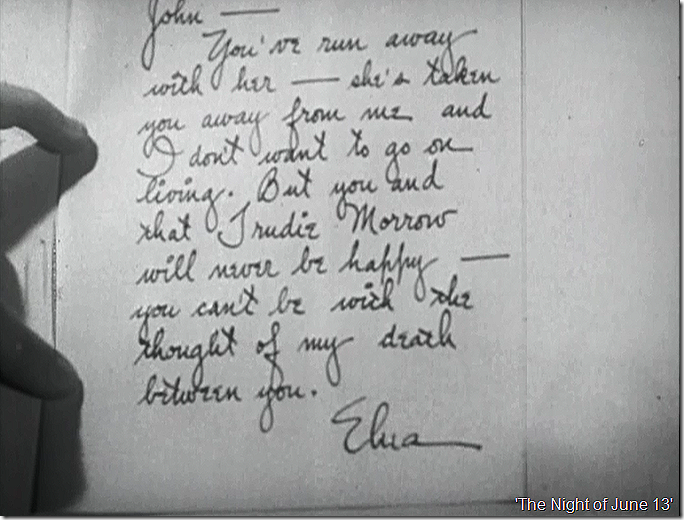
To protect Trudie, John destroys Elna’s suicide note, and is thus suspected of murder.
Caspary bragged of “Suburb,” “Ten years later, Paramount still gave out mimeographed copies to show how an original (narrative material written directly for the screen) should be done.”
But despite its apparent acclaim, finding a published copy of “Suburb” is problematic. A story in Caspary’s collected papers at the University of Wisconsin is titled “The Night of June 13th” (Box 10, Folder 9) and possibly this is it. The archives also include “Odd Thursday,” a reworking of “Suburb” that was the basis of “Such Women Are Dangerous” (1934). Unfortunately, a trip to Wisconsin is far beyond the travel budget of the L.A. Daily Mirror, so I will leave it to another researcher to pursue the matter. Here is a link to the the finding aid for Caspary’s papers.
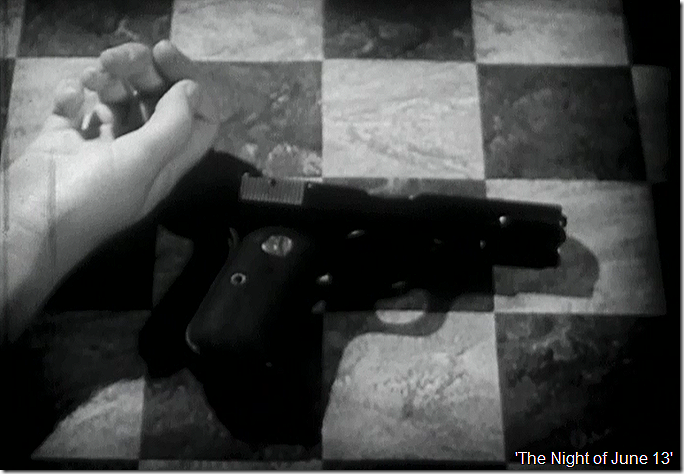
The death of Elna Curry (Adrianne Allen) in “The Night of June 13.”
I was able to track down four films made from Caspary’s story: “The Night of June 13” released in 1932 by Paramount, which was based on “Suburb” and adapted by Agnes Brand Leahy, Brian Marlow and William Slavens McNutt; “Private Scandal,” released in 1934 by Paramount, based on a story titled “In Conference” with a screenplay by Garrett Fort; “Such Women Are Dangerous” released by Fox in 1934, based on a version of the story titled “Odd Thursday” with a screenplay by Jane Storm and Oscar M. Sheridan and additional dialogue by Lenore Coffee; and “Scandal Street,” another reworking of “Suburb,” released by Paramount in 1938, with a screenplay by Bertram Millhauser and Eddie Welch.
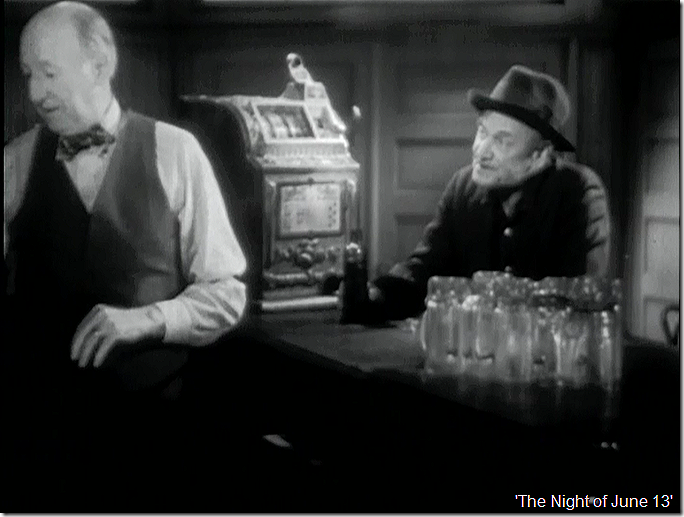
Otto the bootlegger (Richard Carle) and Grandpa (Charles Grapewin) in “The Night of June 13.”
“The Night of June 13” (available online) is a tedious chestnut about a group of despicable neighbors in a commuter suburb of a big city — all of them stock characters of 1930s films, the standard types that W.C. Fields liked to lampoon: bratty kids, snooty, gossipy small-town matrons, henpecked husbands and young headstrong lovers whose parents don’t approve.
There is one very loony wife, Elna Curry (Adrianne Allen), who suffers (oh how she suffers) in her madness before committing suicide under the impression that her husband, John (the stiff, wooden Clive Brook) is involved with neighbor Trudie Morrow (Lila Lee). The only remarkable character is Grandpa, a snoopy, tottering, toothless old sot played by Charles Grapewin, who is best remembered today as Uncle Henry in “The Wizard of Oz” and Grandpa in “The Grapes of Wrath.”
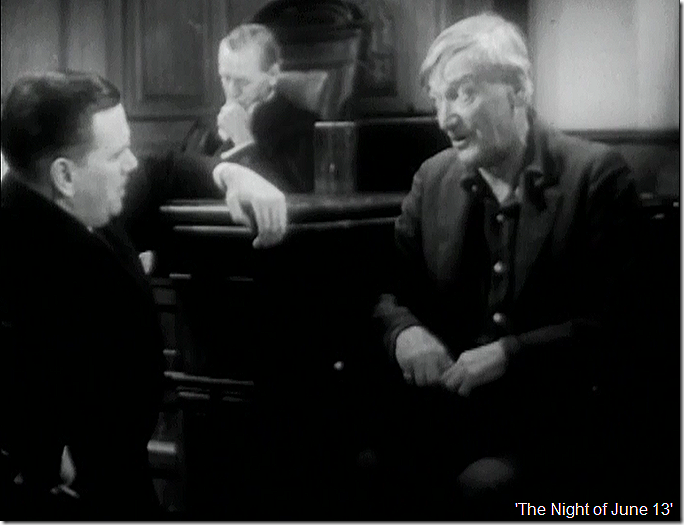
Defense attorney Wallis Clark questions Grandpa (Charles Grapewin) as the judge (Frederick Burton) listens.
In the film’s denouement, there is a trial with a lot of huffing and puffing about “This is highly irregular!” with the judge (Frederick Burton) pounding his gavel and commanding “Order in the court!” Testimony finally exonerates John and all ends well.
To be continued.


I’ve seen THE NIGHT OF JUNE 13TH in a film print and enjoyed it. It’s a melodrama, not a film noir like LAURA, and more about the relationships between the characters than a murder mystery. It shows “regular” people going about their lives. I discovered in research that the train station used was out in the Redlands area. The two stories couldn’t be more unalike.
LikeLike
If you;re going to write about “Laura,” you HAVE to include the Spike Jones version of the great theme song: https://www.youtube.com/watch?v=LZ5_UXE9RMM
LikeLike